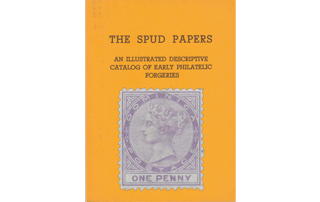Album Weeds – Antigua
 1863-86. One Penny.
1863-86. One Penny.
There are several varieties of this stamp: 1863, small star, rough perf. 14 to 16, lilac-rose, dull rose, vermilion; 1873, CC, perf. 12 1/2, lake, scarlet; 1873, CC, perf. 14, lake, lake-rose; 1884, CA, perf. 12, carmine-red; 1886, CA, perf. 14, carmine-red, rose. The stamp which the forgers have tried to imitate is the vermilion one of 1863.
Genuine
Engraved in taille-douce, machine-perforated 14 to 16, compound, on pinkish-white paper; watermark, star. The groundwork, behind the head, is composed of strips of two different patterns of engine-turning, disposed alternately, nine in all. Each strip is separated from its neighbors by a fine white vertical line ; the central strips being, of course, more or less hidden by the head. The first and last strips have 17 very prominent, diamond-shaped dots running down their centers. One of the inner rows, bearing the same pattern as the two just mentioned, shows one of these dots, just where the hair springs, on the forehead, below the coronet; and this dot is a little larger than the rest. There are two rows of jewels in the band of the coronet; the top row consists of pearls, and the lower row of a few oblong jewels. The lower half of the ear is visible ; the face is shaded all over, as is also the neck ; and there is no shading behind the face, on the background, except just beneath the chin.
Forged
Lithographed, on yellowish paper, pin-perforated 13, no watermark. The beautiful engine-turning in the groundwork of the genuine is here represented by dots. The 17 dots on the outer rows are not at all conspicuous, and would hardly be noticed at a first glance. Where the hair springs, in front of the forehead, beneath the coronet, there is a dim blotch, not at all resembling the sharply-defined dark spot in the same place in the originals. The band of the coronet is jeweled with two rows of pearls; but there is one of the oblong jewels to be seen under the second cinquefoil. There is an indistinct mark where the ear ought to be; but it would require a very strong effort of imagination to
resolve this mark into an ear. The lower part of the cheek and the back of the neck are heavily shaded (I do not refer to the dark shading on the background behind the neck, as this is common to both genuine and forged), and the upper part of the cheek, below the eye, is left unshaded. The background is shaded behind the whole profile of the face.
 1862-86. 6d green.
1862-86. 6d green.
The following are the varieties:—1862, no watermark, rough perf. 14 to 16, blue-green; 1863, small star, same perforation, blue- green, yellow-green; 1873, CC, perf. 12 1/2, blue-green; 1873, CC, perf. 14, blue-green; 1884-86, CA, perf. 14, deep green.
Genuine
Engraved in taille-douce, varieties as above. The die is exactly the same as the id., value only excepted, and therefore the tests for the genuine id. will hold good for the genuine 6d.
Forged
Lithographed, pin-perf. 13, no watermark. This forgery need not detain us long, as it is from the same matrix as the forged 1d., value only excepted, so that the tests for the forged 1d. will hold good for the forged 6d. The color varies from a pale chalky green to a fair imitation of the blue-green tint; it is printed on very white wove paper.
Postmarks.
Genuine.—1, 54, 64. Our readers will probably be aware that the id. was postmarked A12 for St. Christopher in 1890, and A18 for Barbuda.
Forged.—37, 38, 42, all without central numerals.
From: ‘Album Weeds’, 3rd edition by R. B. Eareé. 1906
![]() See also —> Spud Papers – Antigua
See also —> Spud Papers – Antigua












Leave a Reply
Want to join the discussion?Feel free to contribute!